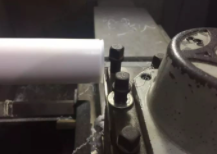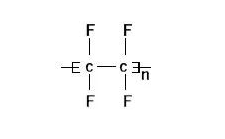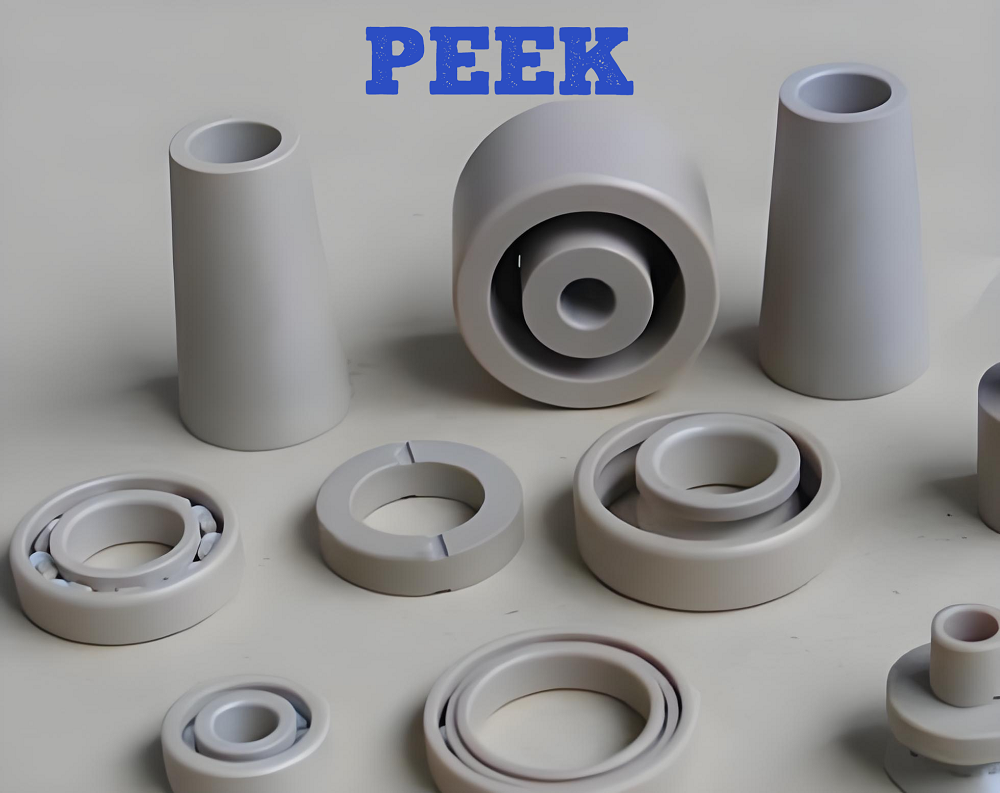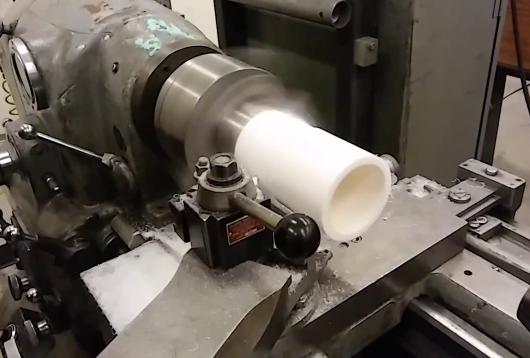- Home
- Machining techniques
- CNC Machining Services
- Cooperative supply services
- Designs
- Materials
- Finishing Services
- Shop
- Products
- Guide
- About Us
- Contact Us
2023.3.31
Polytetrafluoroethylene (PTFE) is a kind of high molecular material with amazing chemical stability and heat resistance, but it is also difficult to process. Here are some suggestions for improving the machining quality of polytetrafluoroethylene workpieces.

Usually, the cutting process of PTFE materials can be carried out on commonly used metal cutting machines, but compared to metal material cutting, its processing standardization is not yet very perfect. Its machinability, cutting rules, tool structure, and cutting amount are different from those of metal material processing. Traditional processing techniques and fixtures often cannot meet the design accuracy requirements of the product.
The stiffness, hardness, and strength of polytetrafluoroethylene materials are relatively small, with tensile strength of 21-28MPa, bending strength of 11-14MPa, and elongation of 250% -300%. Under long-term stress, it will deform, and creep is prone to occur when overloaded. Due to the above performance characteristics of polytetrafluoroethylene, it has unique process characteristics during cutting processing.
(1) Low cutting force. Due to the low stiffness, strength, and hardness of polytetrafluoroethylene, the main cutting force for cutting 45 steel under the same cutting conditions is 14-20 times that for cutting polytetrafluoroethylene material.
(2) Polytetrafluoroethylene material has a small thermal conductivity of only 0.27W/M • K-1, and with a lower heat resistance temperature, its maximum heat resistance temperature is only 250 ℃. If the cutting amount is too large and the cutting speed is high, the cutting temperature of the workpiece will increase, which will soften the PTFE material and even cause melting, coking, and “sticking” phenomenon.
(3) Polytetrafluoroethylene (PTFE) has a large coefficient of thermal expansion, so the PTFE material will generate large heat due to friction in the cutting process, which is easy to overheat the tool and workpiece locally, resulting in elastic deformation of the PTFE workpiece when heated, and ultimately affecting the surface quality and dimensional accuracy of the PTFE material workpiece.
(4) Compared to metal materials, the elastic modulus of polytetrafluoroethylene is very low. When the cutting feed rate is too large or the speed is too fast, the combined effect of large machining friction and the force exerted by the tool on the workpiece causes significant deformation of the polytetrafluoroethylene workpiece, thereby affecting the machining accuracy of the polytetrafluoroethylene workpiece.
(1) Selection of Tool Materials
When cutting polytetrafluoroethylene materials, tool materials are generally carbon tool steel, alloy tool steel, and high-speed steel. Compared to cutting tools, the hardness of the workpiece material is relatively low, so the hardness of the cutting tool has little impact on the processing quality of PTFE material workpieces.
(2) Geometric parameters of the tool
Tool rake angle: For PTFE materials, due to the low strength and hardness of the workpiece material, a relatively large rake angle should be selected to reduce cutting force and cutting heat.
Tool back angle: PTFE material has low hardness and strength, and the greater the plasticity. Therefore, a larger back angle should be selected during mechanical processing to reduce the friction between the tool and the PTFE workpiece, thereby reducing local overheating of the workpiece and improving the processing quality of the workpiece surface.
(3) Selection of cutting parameters
Due to the low strength and hardness of polytetrafluoroethylene material, compared with metal products, relatively large cutting amount and high cutting speed can be selected during cutting. However, polytetrafluoroethylene has low thermal conductivity, high coefficient of thermal expansion, and is prone to deformation and coking caused by local overheating under large feed amount and high cutting speed. Therefore, in order to improve the processing quality and accuracy of polytetrafluoroethylene materials, while ensuring a certain processing efficiency, it is necessary to choose a smaller cutting amount and a lower cutting speed as much as possible.
(4) Other measures
During the cutting process of polytetrafluoroethylene material, due to the soft material of the workpiece, it is easy for the workpiece to deform under high clamping force, which affects the machining accuracy. Therefore, its clamping force is not too large. At the same time, polytetrafluoroethylene workpieces need to be promptly cleaned of chips during cutting and processing, and measures such as adding chip breaking grooves can be taken to ensure timely discharge of chips.
1. PTFE turning processing
The outer diameter, inner and outer ovality, as well as inner and outer conicity of the fluoroethylene material Polytetra have significant and irregular changes during turning processing. Therefore, during the turning process, the front corner of the workpiece should be larger during rough machining to reduce cutting force and prevent elastic deformation of the workpiece; During precision machining, a smaller rake angle can be used to improve tool heat dissipation conditions and reduce cutting temperature.
2. PTFE drilling processing
The biggest problem with PTFE materials during drilling processing is how to remove chips in a timely manner. In general, the following measures can be taken:
(1) Use a small spiral angle and a drill bit with a chip holding groove to facilitate chip removal;
(2) Try to reduce the speed of the drill bit as much as possible, select a lower feed rate while ensuring drilling efficiency, and use multiple tool retractions to ensure timely chip removal, thereby improving the surface quality and machining accuracy of drilling processing.
The spiral angle of a general drill bit after grinding is about 10o~15o, the back angle is 9o~20o, and the cone angle of the drill bit is 60o~120o. The drilling speed used is not only related to the material being drilled, but also to the size and depth of the drilling hole. Generally, a hand electric drill has the best effect at a drilling speed of 900r/min, while a fixed bench drill has the best effect at a rotating speed of 2100r/min and a feed rate of 1.3mm/s.
3. Polytetrafluoroethylene milling processing
When milling polytetrafluoroethylene materials, the rake angle of the milling cutter should be larger than that of the milling metal, and the rake angle of the milling should be greater than 6o (usually between 6o and 15o). The back angle of the milling cutter should also be larger than that when milling metal, and the back angle should be greater than 10o (usually between 15o and 30o). The cutting speed during milling should be controlled within the range of (180-300) mm/min, with a feed rate of (0.05-0.13) mm/r and a feed rate of approximately 0.1mm/s. The surface roughness value decreases with a decrease in feed rate. It is recommended to use side milling method in production to avoid workpiece burns. In addition, when rough machining polytetrafluoroethylene materials, linear tooth back milling cutters with high strength and simple manufacturing should be selected; When performing precision machining, it is recommended to choose a foldable tooth back milling cutter with smaller strength but larger chip capacity.
 Properties and Application of Polytetrafluoroethylene (PTFE) | CNCLATHING
Properties and Application of Polytetrafluoroethylene (PTFE) | CNCLATHING
 Characteristics & Surface Treatment Methods Of PTFE Plastic – Teflon CNC Machining Material
Characteristics & Surface Treatment Methods Of PTFE Plastic – Teflon CNC Machining Material
 PTFE Overview: Pros & Cons, Characteristics, CNC Machining PTFE
PTFE Overview: Pros & Cons, Characteristics, CNC Machining PTFE
 PEEK vs PTFE Plastic: Properties, Formula, Temperature, Price, Uses Differences
PEEK vs PTFE Plastic: Properties, Formula, Temperature, Price, Uses Differences
 Spring Material Types (Properties, Grades, Uses) & Best Selection for Your Project
Spring Material Types (Properties, Grades, Uses) & Best Selection for Your Project
 CNC Machining PTFE: PTFE Plastic Overview & Teflon Machining Tips | CNCLATHING
CNC Machining PTFE: PTFE Plastic Overview & Teflon Machining Tips | CNCLATHING
